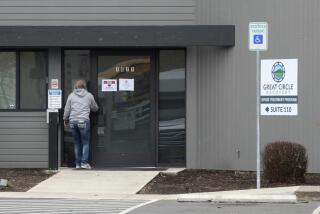City May Soon Be Wetting Whistle
- Share via
MONMOUTH, Ore. — The last legal drink sold in this town founded by Christian pioneers changed hands in 1858, back when the West was still wild, the Eastern railroads ended on the Great Plains and Oregon had yet to earn its star on the American flag.
The next legal drink could be sold as soon as January, ending Monmouth’s claim as the last dry city on the West Coast.
Voters in this community of tree-shrouded, wood-frame houses decided Nov. 5 to allow beer and wine sales in hopes of reviving the local retail district and attracting a grocery store. The town of 7,800 has been without a market for two years.
“We hardly have a downtown as it is,” said Carol Nelson, who has lived on a 240-acre farm at the edge of the city for more than 30 years. “We’d all like to have a nice restaurant, and have a glass of wine with dinner.”
Townsfolk say there’s a certain cachet, a self-conscious embrace of idiosyncrasy, that comes with being able to say you live in a dry town in the middle of a place known both for its wine grapes and its hops, a key ingredient in beer.
But what was once a novelty became an inconvenience to longtime residents like Lew Pinnock, a retired Western Oregon University biology professor, who voted against alcohol sales during the last referendum in 1976 but switched sides this time.
“I decided that it was ridiculous, for the feeling of being special, to jeopardize the town’s welfare,” said Pinnock. “We don’t need a dry law to make us special.”
The turning point for many longtime residents came two years ago, when the Market Place, Monmouth’s last grocery store, went out of business in part to competition from stores in the adjoining city of Independence, which allows alcohol sales. It’s one thing to leave town to buy beer; it’s another to have to leave to buy toilet paper.
“Nobody shops in town for hardly anything,” said Nelson, whose husband is a former mayor.
The store’s closing led John Oberst, a stay-at-home dad and former high school biology teacher, to launch a grass-roots campaign to end what he and other local boosters saw as a hurdle to reviving a downtown of low buildings, many of them vacant.
“I really did feel the Market Place closing was the last straw for me,” said Oberst, a native Kentuckian. “We were killing our commercial base.... I saw Monmouth in a downward spiral.”
Monmouth was founded in the early 1850s by members of the Christian Church of Monmouth, Ill., who followed the Oregon Trail in search of a place to open Monmouth University, a Christian college. In 1858, confronted with a merchant selling “spiritous and vinous liquors,” the town fathers persuaded the Oregon Territorial Legislature to grant Monmouth a charter allowing it to regulate business -- and ban alcohol sales.
Even today, Monmouth’s biggest employer and dominant institution is the 5,000-student Western Oregon University, a public school descended from the original college. And while the city counts more than a dozen churches, it has no industry, declining property values and few places for the hungry to find a good meal.
Housing values reflect the economic torpor. The average sales price of a single-family home in August was $138,000, down about $4,000 from the same time in the prior year.
The November election -- 58% voted to go wet -- was the sixth time the issue has gone to a public vote. The last repeal effort, in 1976, was defeated by more than 75% of voters. Things have changed since then, said local historian Kyle Jansson. Growth has made Monmouth a bedroom community for workers in Salem and Corvallis, both larger cities with higher housing costs about half an hour’s drive away. “That added outside viewpoints to the debate,” Jansson said.
Also, the last members of the Women’s Christian Temperance Union moved away in the late ‘80s, leaving the philosophical descendants of Carrie Nation without a flag bearer.
On a recent afternoon, pedestrians in the four-block business district were outnumbered by a small work crew replacing sidewalks. Occasionally, cars crept along East Main Street, the downtown strip.
“There are not a lot of places for students to hang out,” said Miranda Wagner, 21, a junior social sciences major who is hoping the town will now get some night life. “It would be so much easier to walk to a bar than to drive to Independence.”
Predictably enough, many Western Oregon students aligned behind the repeal, although some voted against it, saying they didn’t think lifting the ban would do much for the town.
They joined teetotaling traditionalists who, alarmed by visions of bar fights and drunks urinating in public, saw no need for change.
“The town was very nice the way it was,” said Don Dutcher, 66, who retired with his wife, Patty, from Portland to Monmouth two years ago to escape urban sprawl. “The people that wanted it [wet] stated that the town needed to grow, that the town needed a shot in the arm. That’s not going to happen.”
For Dutcher and others opposed to ending the ban, the argument that alcohol sales would spark a renaissance was a red herring.
Monmouth, they argued, isn’t the kind of town in which the sale of alcohol will make or break a business.
But Oberst and others point to the opening in recent years of two food stores in Independence -- both selling beer and wine, one near the city line -- as evidence that the alcohol ban was hurting Monmouth’s ability to draw new business.
Still, some who voted to end the ban are dubious about the benefits, although they say they’ll be happy when they can buy a drink in town.
“I don’t think what they’re going to do is going to change the flavor much,” said Nelson.
At least one student also figures the odds are against improvement.
“I thought we were doing pretty good,” said Jennifer Myers, 20, a business major who voted against the measure. “Now people will get drunk and be stupid.”
*
Times researcher Lynn Marshall contributed to this report.
More to Read
Sign up for Essential California
The most important California stories and recommendations in your inbox every morning.
You may occasionally receive promotional content from the Los Angeles Times.











